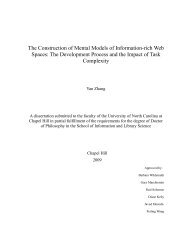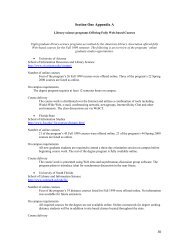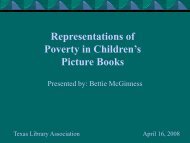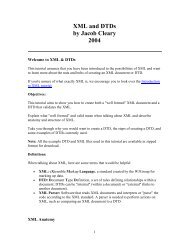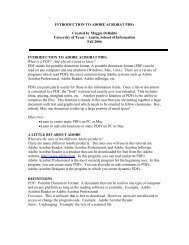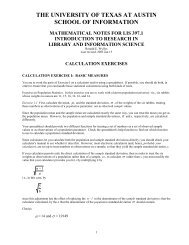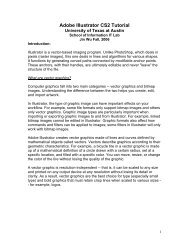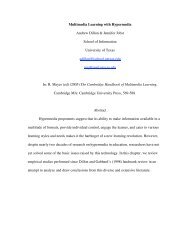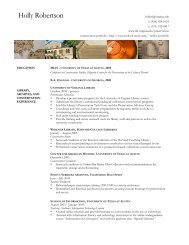North American Graduate Programs in the Conservation of
North American Graduate Programs in the Conservation of
North American Graduate Programs in the Conservation of
You also want an ePaper? Increase the reach of your titles
YUMPU automatically turns print PDFs into web optimized ePapers that Google loves.
FOREWORD<br />
It seems appropriate, on <strong>the</strong> occasion <strong>of</strong> <strong>the</strong> Twenty-fifth Conference <strong>of</strong><br />
<strong>the</strong> Association <strong>of</strong> <strong>North</strong> <strong>American</strong> <strong>Graduate</strong> <strong>Programs</strong> <strong>in</strong> <strong>the</strong><br />
<strong>Conservation</strong> <strong>of</strong> Cultural Property, to reflect upon <strong>the</strong> very significant<br />
effect <strong>of</strong> <strong>the</strong>se formal graduate tra<strong>in</strong><strong>in</strong>g programs <strong>in</strong> <strong>in</strong>creas<strong>in</strong>g <strong>the</strong> pr<strong>of</strong>essionalism<br />
<strong>of</strong> <strong>the</strong> field <strong>of</strong> conservation as a whole <strong>in</strong> <strong>North</strong> America.<br />
My career parallels closely <strong>the</strong> development <strong>of</strong> <strong>the</strong> field, extend<strong>in</strong>g from<br />
apprenticeship tra<strong>in</strong><strong>in</strong>g <strong>in</strong> a museum laboratory <strong>in</strong> <strong>the</strong> 1950s, through<br />
direct<strong>in</strong>g a regional center laboratory and head<strong>in</strong>g its graduate tra<strong>in</strong><strong>in</strong>g,<br />
and conclud<strong>in</strong>g with twenty years as head <strong>of</strong> a major museum conservation<br />
laboratory that has had a cont<strong>in</strong>uous flow <strong>of</strong> <strong>in</strong>terns and postgraduate<br />
fellows from graduate tra<strong>in</strong><strong>in</strong>g programs <strong>in</strong> <strong>the</strong> United States and<br />
abroad. I speak, <strong>the</strong>refore, from experience.<br />
From <strong>the</strong>ir beg<strong>in</strong>n<strong>in</strong>gs, <strong>the</strong> graduate tra<strong>in</strong><strong>in</strong>g programs have fostered an<br />
openness and shar<strong>in</strong>g <strong>of</strong> <strong>in</strong>formation among conservators that came as a<br />
breath <strong>of</strong> fresh air to a field that had traditionally been ra<strong>the</strong>r closed and<br />
secretive, perhaps reflect<strong>in</strong>g <strong>the</strong> <strong>in</strong>security felt by <strong>in</strong>dividual practitioners.<br />
This shar<strong>in</strong>g <strong>of</strong> <strong>in</strong>formation between <strong>in</strong>dividuals, programs, and laboratories<br />
has been encouraged by <strong>the</strong> faculty <strong>of</strong> <strong>the</strong> various tra<strong>in</strong><strong>in</strong>g programs<br />
from <strong>the</strong> start.<br />
<strong>Conservation</strong> documentation across <strong>the</strong> field has markedly improved,<br />
<strong>in</strong> exam<strong>in</strong>ation reports, treatment records, and photodocumentation, as a<br />
result <strong>of</strong> careful tra<strong>in</strong><strong>in</strong>g by program faculty. This contrasts with <strong>the</strong> brief,<br />
if any, descriptions <strong>of</strong> treatment left by our predecessors earlier <strong>in</strong> <strong>the</strong> century.<br />
Students are tra<strong>in</strong>ed to do thorough exam<strong>in</strong>ations before treatment<br />
and to use a wide range <strong>of</strong> exam<strong>in</strong>ation techniques, unknown <strong>in</strong> <strong>the</strong> earlier<br />
days <strong>of</strong> <strong>the</strong> pr<strong>of</strong>ession. Conservators have become much better problem<br />
solvers because <strong>of</strong> <strong>the</strong>ir tra<strong>in</strong><strong>in</strong>g program experience.<br />
Approaches to treatment problems have broadened as a result <strong>of</strong> more<br />
practitioners seek<strong>in</strong>g solutions through test<strong>in</strong>g. No longer is only one solvent<br />
or one adhesive used to treat most problems. More <strong>of</strong>ten, materials<br />
and techniques are tailored to specific treatment problems.<br />
As a result <strong>of</strong> <strong>the</strong> more comprehensive exam<strong>in</strong>ation techniques, much<br />
more is known and understood about artists' materials and methods.<br />
Major catalogues now generally <strong>in</strong>clude technical material, and, <strong>in</strong> fact,<br />
fund<strong>in</strong>g agencies <strong>of</strong>ten will not support <strong>the</strong>ir publication unless <strong>the</strong>y con-<br />
vii



